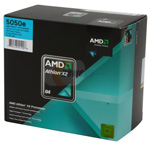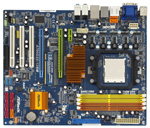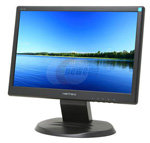System Buyers Guide: PCs for Under $1000
by Wesley Fink on December 29, 2008 3:00 AM EST- Posted in
- Guides
AMD Entry-level PC
Compared to a year ago our Entry AMD system uses a dual-core CPU with the same 2.6GHz speed. This year that CPU costs over 40% less and consumes half the power of last year's X2. That is certainly progress. With memory so cheap, we have also doubled our recommendation to 4GB. You can go with 2GB and save $13, but that money is well spent in doubling memory, particularly if you want to jump on the Vista 64-bit bandwagon, and honestly we see very few reasons to hold off. The hard drive is now 500GB, doubling the capacity from a year ago for the same price.
| AMD Entry-level PC | ||
| Hardware | Component | Price |
| Processor | Athlon 64 X2 5050E Brisbane (Dual-core 2.6GHz 45W 2x512KB L2) |
$63 |
| Cooling | CPU Retail HSF | - |
| Video | Onboard | - |
| Motherboard | ASRock A780GXE/128M 780G | $80 |
| Memory | Kingston 4GB DDR2-800 Kit (KVR800D2N5K2/4G) | $37 |
| Hard Drive | WD Caviar GP WD5000AACS 500GB | $59 |
| Optical Drive | Samsung 22X DVDRW/DL SH-S202G | $25 |
| Audio | Onboard | - |
| Case | Rosewill TU-155 with 400W | $60 |
| Power Supply | Included with Case | - |
| Display | Hanns-G HB-175APB 17" 8ms Widescreen LCD Monitor Built in Speakers - Retail (1440x900) | $99 |
| Speakers | Built into Monitor | - |
| Input | Microsoft CA9-00001 PS/2 Standard Keyboard and Optical USB/PS2 Mouse - OEM | $16 |
| Operating System | Microsoft Vista Home Premium OEM | $99 |
| Bottom Line | $538 | |
 |
Prices on all processors are continuing to drop in the face of the continued, aggressive pricing strategy adopted by Intel. The AMD 2.6GHz dual-core is an excellent value at just $63. If you want even more power the Phenom 8750 tri-core is a good value at just $57 more, and that also moves you to the Phenom architecture instead of the older K8. However, for most users the Athlon 64 X2 5050E provides plenty of power for an entry AMD system. If you're counting pennies you could even drop down to a single-core 2.6GHz Orleans 45W processor for $36 and save $27.
The 780G chipset is one of the best budget IGP designs we have worked with over the years. This is the chipset that made integrated graphics relevant again. One of the best boards in this price category is the ASRock A780GXE. The A780GXE features the ATI Radeon 3200 integrated graphics. ASRock loads the board with six 3Gb/s SATA ports featuring RAID 0/1/10, 5.1 HD audio, Gigabit LAN, two PCI-E x16 slots, one PCI-E x1 slot, three PCI slots, and support for 16GB of memory. Durability is addressed with solid capacitors for CPU power and duracap long-life capacitors for the rest. This board has been rock solid for us and supports AM2/AM2+ and the upcoming AM3.
 |
The 780GXE has 128MB of sideport memory for additional performance. It fully supports the 140W Phenoms, and it can do dual x8 Crossfire. The 780GXE used to be a $90 board, so it is a good value at the current $80 price. It is ATX format, and ASRock also manufactures the 780FullDisplayPort motherboard, which at $10 less may be a better choice for those pinching pennies. The extra performance of sideport memory for the $10 price difference is worth it. However, for those who never worry about upgrades, the A780FullDisplayPort is a great choice, plus ASRock is currently throwing in a DisplayPort card and DVI to HDMI converter with the 780FullDisplayPort.
With DDR2 prices so very low, we went for 4GB of DDR2-800 this time. This is double last year's entry recommendation for less than half the price. This 50% to 75% drop in DDR2-800 memory prices in the past year is why you're not seeing much memory advertising these days. RAM prices as a whole are certainly in the commodity category as of late. We recommended the Kingston 4GB DDR2-800 kit, but you could just as easily choose OCZ, G.Skill, Corsair, Crucial, GeIL, Patriot, or any other quality DDR2-800 name and shop for the memory based on a combination of price and the company's support reputation. Again, if you are truly pinching pennies you can save about $13 by going with 2GB of memory instead.
Hard drive capacity continues to grow, as you can see in our selection of the Western Digital Caviar 500GB for our entry system. It seems a waste to choose a lower HD capacity when 500GB is now available for around $60 - even from www.amazon.com. While there are differences between hard drives, outside of running benchmarks most people aren't likely to notice the difference in performance between Western Digital, Seagate, Samsung, Hitachi, and other major brands. All are worthy of consideration if the price per gigabyte (or terabyte) is right.
For the optical drive we went for value with the dependable Samsung 22X DVDR. With the rise of the 25GB/50GB Blu-Ray burners, DVD writers have continued to drop in price. A DVD writer that supports double-layer and 22X DVD writes for $25 is a bargain indeed.
 |
The last major component to discuss is the display, and here the tilt was toward price. $99 is a really low price for an LCD monitor, and the Hanns-G is a 17" widescreen that supports a native resolution of 1440x900. This is the resolution supported by most 19" and 20" widescreen monitors. You will not give up resolution with this monitor, but things will be a bit smaller. If your budget allows, you can choose the 19" Acer X193Wb with the same 1440x900 resolution at $130, or a 22" Acer X223Wbd, with 1680x1050 resolution for $170. LCD monitors have dropped in price, moved to widescreen format, and generally improved in image quality, even with the lower prices. 22" is today's sweet spot, since the next step up to 24" starts at around $300. If your budget can stretch to $170, that is money well spent on a 22" widescreen display.










38 Comments
View All Comments
Wixman666 - Monday, December 29, 2008 - link
Nonsense, you're forgetting that they are posting builds that are user friendly for the general public. 99% of the people in the US couldn't install Linux if their life depended on it. Even for many supposed "power users" it is not exactly friendly.While it is indeed a good alternative, Linux is still just not for the mainstream.
You guys also neglected to choose Vista 64 for forward thinking. Buying a 32 bit OS today is like throwing away money. If I wanted a 32 bit OS I'd buy XP home, pro, or media center.
n0nsense - Tuesday, December 30, 2008 - link
People in US do install and use Linux like in any other place.Dumb
Anyway you will install some OS and installing Vista is at least longer process at the first time and "find the drivers CD" on next time since even NIC wont work out of the box in most cases (XP much worse with default drivers).
And usability, if my 60 years old (in average) parents can use it without calling me few times a week (like they did with XP), anyone can :)
strikeback03 - Monday, December 29, 2008 - link
I'd guess that most users considering assembling their own computers (and for that matter most users who can put a CD in the drive) could install Ubuntu. And with reasonably mainstream hardware they might even have it run flawlessly. If you are willing to use the forums and such to find help you probably can get it to run on just about any system. The problem is that lots of people want it to just work, and you never know what you are getting with each new release. I have been using Ubuntu since 6.10 on my desktop and 7.04 on my laptop. Each release I have installed on the desktop has required new kernel flags to work around problems (noapic, nolapic, all_generic_ide, etc), and the 7.04, 7.10, and 8.04 LiveCDs didn't even boot without help. With 8.10 they seem to have fixed all that, I still haven't gotten around to actually installing it but it runs perfectly off a flash drive. My laptop (Thinkpad T43) , OTOH, had zero problems with any of the releases prior to 8.10, everything did just work. So I went ahead and installed 8.10 without any trial period, and it broke Wireless support, so that it would constantly disconnect from the router, then most times ask for the password on reconnecting and sometimes refusing to reconnect at all. Obviously not acceptable, so I went back to 8.04.I have installed Ubuntu on several other systems at work without problems (including one which is almost identical to my troubled desktop), but the point is that a lot of users probably don't want the uncertainty of whether their hardware will be happy with the software or not. Not that Vista has a spotless hardware support history, but most users probably feel more comfortable finding support for that than Linux.
JarredWalton - Monday, December 29, 2008 - link
Actually, we didn't specifically state whether you should buy the 64-bit or 32-bit version, though we did mention that 64-bit is the way to go if you run 4GB or more RAM. There's only a couple applications I use regularly that utterly fail under 64-bit Vista: Dragon NaturallySpeaking (still waiting for their 64-bit update!) and Gametap (a bunch of the games fail to install/work under 64-bit Vista). So it's still not 100% the same as 32-bit, but I do run 64-bit for my primary gaming PC. My work PC remains 32-bit until the Dragon issue is fixed.sprockkets - Monday, December 29, 2008 - link
If you can assemble a computer, you can install Linux.By the way, that WD Green drive has NEVER been a variable speed drive; it operates at 5400rpm ALL the time. WD just doesn't want the public to fret over the fact that it is a 5400rpm drive so they obfuscate this fact as much as possible.
cbutters - Monday, December 29, 2008 - link
I was just about to post that the WD wasn't a variable speed drive, but I see you have commented on it already, therefore, I second your post.n0nsense - Monday, December 29, 2008 - link
Truly, I can't understand why 20% of computer cost should be spent on OS.Yes, you can argue that other OS does not really support ALL games.
But when talking about Internet/Office/Media non professional use (in professional people can choose Mac) for what f... reason should person to spend this 100 USD on something really not needed. Actually it's more then 100$ since they gonna need "good anti everything" soft which will slow down their already not so fast computers.
On the other hand they can opt for something like Mythbuntu for HTPC, or Ubuntu for normal desktop and spend saved money on something better like tripling disk space, getting decent dedicated graphics and other things.
And i'm disappointed that you don't even mention this.
and please, add preview button for posts :)
DerwenArtos12 - Monday, December 29, 2008 - link
Why didn't you all use the Corsair ram you were raving about in your memory guide, it's only a couple bucks more?Wesley Fink - Tuesday, December 30, 2008 - link
We certainly like the Corsair memory as well. As we said in the Buyers Guide:"RAM prices as a whole are certainly in the commodity category as of late. We recommended the Kingston 4GB DDR2-800 kit, but you could just as easily choose OCZ, G.Skill, Corsair, Crucial, GeIL, Patriot, or any other quality DDR2-800 name and shop for the memory based on a combination of price and the company's support reputation."
BernardP - Monday, December 29, 2008 - link
I have had a system based on Asus M3N78-VM GeForce 8200 motheboard for a month. I have all the latest chipset, audio (NVidia + VIA) and video drivers installed. I have tried all possible audio settings and configurations, in WinXP and BIOS. Despite this, I have been unable to get audio through HDMI, although the HDMI video is perfect @ 1280x720.Searching on the net, this seems to be a widespread problem. Some users report they have HDMI audio working, but they don't seem to have done anything special to make it work.
The fundamental problem is that, on my system, there is no visible option to select HDMI audio, either in Hardware Manager or Control Panel/Sounds.
Anyone knows the sure-fire recipe to enable audio through HDMI on the 8200/8300 chipset?